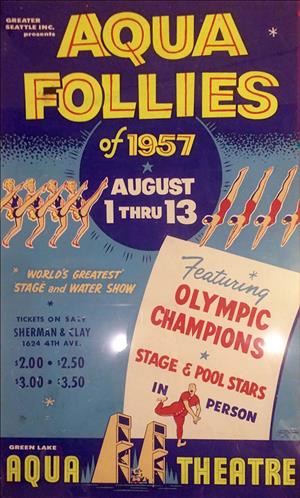One clear starry night in the summer of 1950, the nationally famous Aqua Follies opened Seattle's new Aqua Theatre, an open air stadium on the south shore of Green Lake. The event, on August 11, 1950, was one of the opening attractions of Seafair's first season. A sellout crowd of 5200 came to see water ballet, comedy, and dancers and singers, not to mention high divers plunging from two towers flanking a stage adorned with evergreen. Following a fireworks finale, this first performance of a 10-day stand ushered in a 15-year love affair between summertime theatergoers and Seattle's unique lakeside showplace.
The Aqua Theatre was constructed in only 67 days, at a cost of $247,000. Its successes through the 1950s led to expansion of the seating area in 1960 to an ultimate capacity of 5,582. The fan-shaped concrete grandstand included 940 box seats, priced at $3.50 per event. There were four ticket prices; the cheapest seats, high in the upper corners and without back supports, sold for $2.00.
Jazz, Dance, and Annie Get Your Gun
The Aqua Follies, produced by Greater Seattle, Inc., was only one of the annual summertime productions performed at Green Lake. For several years the Summer Opera Company produced Music Under the Stars under the baton of Gustave Stern, musical director of the Parks Department. The group performed concert versions of popular operettas, complete with ballet, orchestra, and chorus. On a grander scale, elaborately costumed musicals, such as South Pacific, The King and I, Silk Stockings, and Oklahoma made annual visits to the open air stage and its floating orchestra pit.
In 1962, with the Seattle World's Fair drawing large crowds from throughout the country, the Aqua Theatre reached its zenith with five separate productions occurring throughout the summer season. A three day jazz festival began on June 19, 1962, followed in July by week-long performances of Bob Hope; Annie Get Your Gun with Gizele MacKenzie; and Music Man with Bert Parks and Barbara Williams. Capping the bill with a cast of more than 100, the Aqua Follies sustained a 21-day run, ending the Seafair celebration on August 15, 1962.
A Chance of Rain
If Seattle's Century 21 Fair of 1962 boosted the Aqua Theatre to the height of popularity, it also led to its demise. In 1962, as now, Seattle's summer weather was unpredictable. Evening showers or downpours made the stage slippery, causing dancers to improvise steps in order to maintain their balance. Threatening weather frequently led to no-shows at the gate, especially by patrons coming from long distances. The World's Fair brought entertainment opportunities to the Seattle Center, which offered comfortable seating and protection from the elements that the Aqua Theatre could not provide. The Aqua Follies ended in 1964, and after that the white elephant Aqua Theatre could no longer compete for national productions. The facility was used only rarely, mostly for local productions. A Grateful Dead appearance in 1969 was one of the final concerts at the Lake.
During the late 1960s, vandalism and disrepair eventually led to condemnation of the facility. A 1968 Forward Thrust Bond Resolution provided funds to remove the diving towers in 1970, and, later, four of the seven original grandstand sections and all its seating, leaving behind a concrete skeleton. In its place rose a new shell house and a remodel of the original shell house to the north, constructed in 1951.
During winter months, when waters in the Lake are clearest, a close eye can still see the canvas cover of the former pool, laid down to prevent plant growth and the roiling up of the Lake's mud bottom during performances.
Today, with little more than a ghost of the Aqua Theatre remaining, strains of "Gonna Wash That Man Right Outta My Hair" drift across to the north shoreline only in the memory of those who once lived and played in the Green Lake neighborhood more than a generation ago.

